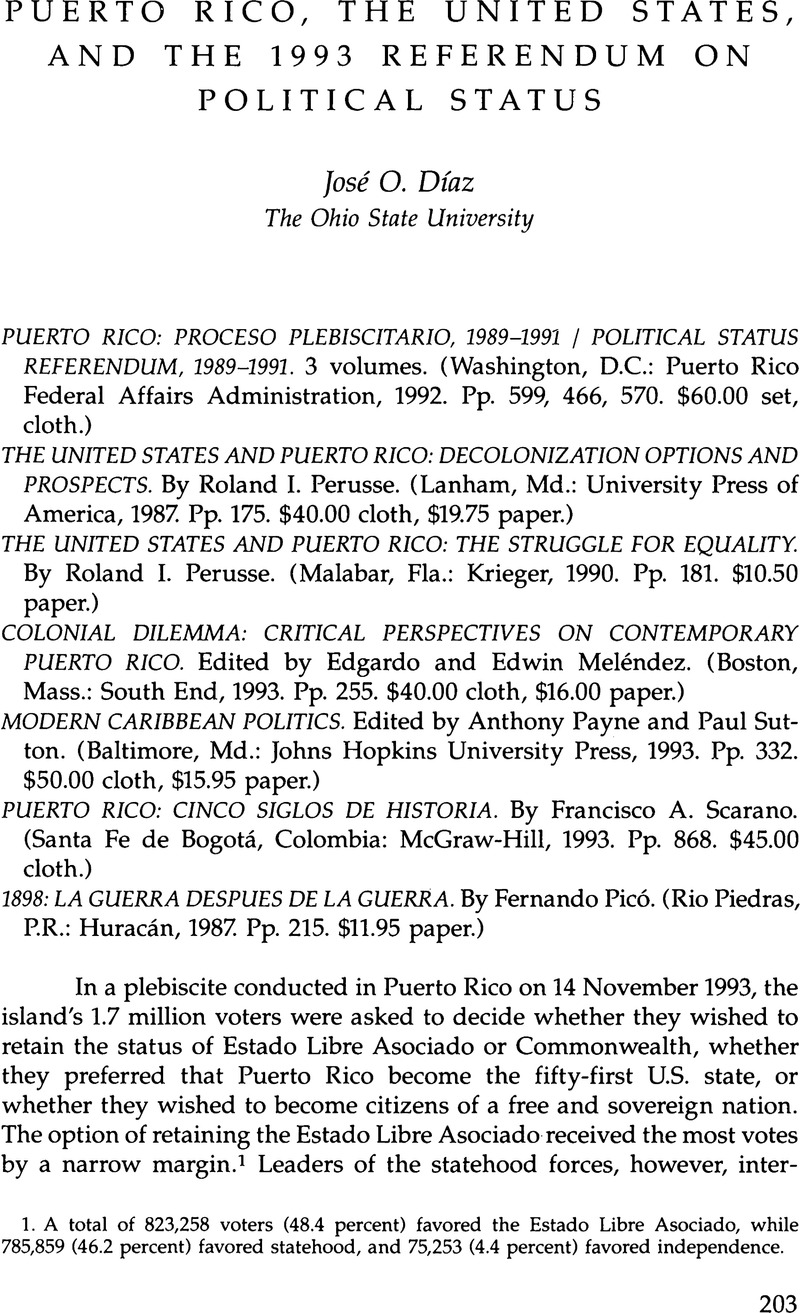Article contents
Puerto Rico, the United States, and the 1993 Referendum on Political Status
Review products
Published online by Cambridge University Press: 05 October 2022
Abstract

- Type
- Review Essays
- Information
- Copyright
- Copyright © 1995 by the University of Texas Press
References
1. A total of 823,258 voters (48.4 percent) favored the Estado Libre Asociado, while 785,859 (46.2 percent) favored statehood, and 75,253 (4.4 percent) favored independence.
2. A plebiscite was held in Puerto Rico on 23 July 1967 in which Puerto Ricans were asked to choose among commonwealth, statehood, and independence. In that referendum, the Estado Libre Asociado or Commonwealth captured 60.5 percent of the vote.
3. The Puerto Rican Statehood Act was introduced by former President Gerald Ford in 1977. The bill states “That this is the sense of the Congress of the United States that the appropriate status for the Commonwealth of Puerto Rico is statehood and that the people of Puerto Rico should be able to achieve this status under the Constitution of the United States if they should so desire. …”
4. See the London publication, Kessing's Contemporary Archives 16 (1967–1968):22, 239; and “Choosing Status Quo: Puerto Rico Avoids Radical Change but Now May Be Ignored by Congress,” The New York Times, 16 Nov. 1993, sec. A, p. 24.
5. See Edgardo Meléndez, Puerto Rico's Statehood Movement (New York: Greenwood, 1988).
6. Three days after landing on Puerto Rican soil, General Nelson Miles proclaimed the purpose of the invasion: “This is not a war of devastation, but one to give to all within the control of its military and naval forces the advantages and blessings of enlightened civilization.”
7. The Treaty of Paris brought the Spanish-American War to a close and sealed Puerto Rico's fate. In accordance with the treaty, Puerto Rico came under U.S. sovereignty after four centuries of Spanish rule.
8. The Foraker Act established a civilian government in Puerto Rico.
9. The Jones Act granted U.S. citizenship to Puerto Ricans.
10. Public Law 600 allowed Puerto Rico to form its own government under its own constitution.
11. This UN resolution demanded “immediate steps” to abolish colonial relations. Under this resolution, any associated state must be free to sever its ties with other countries.
12. On his last day in office, President Ford introduced the Puerto Rican Statehood Act of 1977.
13. In 1982 President Reagan reaffirmed U.S. policy regarding Puerto Rico.
14. See Francisco A. Scarano, Sugar and Slavery in Puerto Rico: The Plantation Economy of Ponce, 1800–1850 (Madison: University of Wisconsin Press, 1984).
15. See Marisa Rosado, Las llamas de la aurora: acercamiento a una biografía de Albizu Campos (San Juan, P.R.: Corripio, 1992); and Ivonne Acosta, La mordaza: Puerto Rico, 1948–1957 (Rio Piedras, P.R.: Edil, 1987).
16. The so-called tiendas de raya (line stores) were the company stores where laborers could buy food and supplies. Strapped by their meager salaries, workers constantly had to borrow against future earnings and found themselves trapped in a cycle of debt. In 1887 Governor Romualdo Palacios, fearing the political machinations of some pro-autonomy groups, ordered a series of preventive measures. These “compontes” included massive arrests, torture sessions, and executions.
- 2
- Cited by


